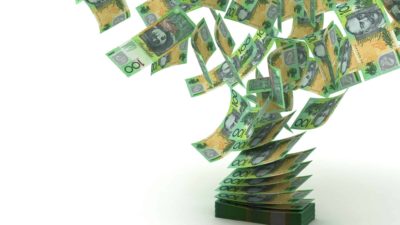Exchange traded funds (or ETFs) are a great way to add diversity, balance and ballast to a portfolio. By investing in dozens or hundreds of stocks and assets in one fund, you can easily gain exposure to a tricky field of investing (such as small-cap stocks or bonds) that you might otherwise feel uncomfortable with.
Here's a $100,000 model portfolio, using some diverse ASX ETFs that you may want to check out if you're interested in pursuing a similar strategy.
iShares Core S&P/ASX 200 ETF (ASX: IOZ) – $25,000
This ETF tracks the ASX200 benchmark, which is what we generally use to measure the performance of the Aussie stock market. This is because the ASX200 follows the biggest 200 public companies in Australia – every big Australian company you can think of will be in there – Coles Group Ltd (ASX: COL), Afterpay Touch Group Ltd (ASX: APT) and National Australia Bank Ltd (ASX: NAB) to name a few. Throwing in a bit of home bias, IOZ would make a good foundation for any portfolio and I'm very happy with its presence here.
Vanguard International Shares Index Fund (ASX: VGS) – $25,000
With this ETF, you are getting a slice of 1,595 companies that reside beyond our shores – which adds some much-needed international balance (in my opinion). VGS holds companies across the USA, UK, Japan and other advanced economies but is not hedged to our Australian dollar, so any currency fluctuations may impact your investment's value. Some of VGS's top companies include Johnson & Johnson, Visa, Amazon and Royal Dutch Shell. Australia only makes up about 2% of the global share market, so looking beyond our shores seems prudent to me.
Vanguard International Credit Securities Index (Hedged) ETF (ASX: VCF) – $25,000
Adding some ballast to your portfolio is always a good idea, and especially pertinent at our current point of the share market cycle. VCF invests in bonds rather than shares and is also currency hedged – meaning currency changes won't affect the fund's value. Bonds are considered a safer and more conservative investment which often outperform shares during bear markets. VCF invests in investment grade bonds issued from government-owned entities as well as corporations, giving you a slightly higher income than you may get from pure Treasury bonds.
BetaShares Global Cybersecurity ETF (ASX: HACK) – $25,000
I've thrown this one in for a bit of fun, but I also think it might have some real growth potential! HACK (yes, that's the ticker) invests in the Nasdaq Cybersecurity Index, tracking mostly US companies that are at the forefront of the cybersecurity and cyber-safety industry, which (I think) is only going to grow in importance over the decades to come as we become ever-more connected online. Some of its top holdings include Symantec Corporation, Cisco Systems Inc. and Raytheon Co.
Foolish Takeaway
With this model portfolio, you can see how simple crafting a balanced investment strategy can be using ETFs. The first three, in particular, can be used very well as diversification vehicles, and if you're feeling confident, HACK might be a good bet as well.







